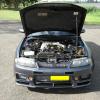Stagea Jerky On And Off Throttle
Announcements
-
Similar Content
-
Latest Posts
-
Yeah everyone always seems to refer to them as S13 wheels however they came on R32 Skyline, A31 Cefiro, C33 Laurel etc., and also came polished diamond cut or painted depending on the model. Congrats on your GTS purchase! I'd personally leave it NA.
-
In this thing about this 100% renewal energy stuff I hear no one really talking about anything other than power and fuel really Power and fuel, whilst being a huge part of how we use the billion year old Dinosaur juices, are only 2, of the probably thousands of things that we need to use it for in the chemicals industries for making nearly everything we use nowadays I'm all for a clean planet, but if we want to continue to have all the day to day appliances and stuff that we rely on everyday we will still need fossil fuels Whilst I do love science, and how it can bring innovation, there's really a limit to how far it can go in relation to "going green" As for EV's, unless your charging of your own solar panels, it isn't helping the environment when you consider the the batteries, the mining processes required, the manufacturing process required, and how long a batteries (read: the vehicle) lasts long term If I was supreme dictator of the world, I would ban the use of sugar for fizzy drinks and food additives and use that for ethanol manufacturing, petrol engines would be happier, and people would be alot healthier Disclaimer: Whiskey manufacturing would still be required, so says the supreme dictator of the world Same same for all the vegetable oils that get pumped into all our food, use that for bio diesel Disclaimer: the supreme dictator would still require olive oil to dip his bread in This would take some of heat off the use of the use of fossil fuels which are required for everything we use, unless you want to go back to pre 1800 for heat and power, or the early 1900's for plastics and every thing else that has come from cracking ethylene Would I be a fair and just dictator, nope, and I would probably be assassinated within my first few months, but would my cunning plan work, maybe, for a while, maybe not Meh, in the end in an over opinionated mildly educated arsehole typing out my vomit on my mobile phone, which wouldn't be possible without fossil fuels And if your into conspiracies, we only need the fossil fuels to last until a meteor hits, or thermonuclear annihilation, that would definitely fix our need for fossil fuels for manufacturing and power issues for quite some time Meh, time for this boomer to cook his lunch on his electric stove and then maybe go for a drive in my petrol car, for fun
-
By joshuaho96 · Posted
It really helps that light duty vehicles have absolutely appalling average efficiency due to poor average load. Like 25% average brake thermal efficiency when peak is somewhere around 38% these days. So even a 60% BTE stationary natural gas plant + transmission and charging losses still doing much better with an EV than conventional ICE. And that's before we get into renewables or "low carbon nonrenewable" nuclear which makes it a no-brainer, basically. In commercial aircraft or heavy duty diesel pulling some ridiculous amount of weight across a continent the numbers are much more difficult to make work. I honestly think in 5-10 years we will still be seeing something like the Achates opposed piston diesels in most semi trucks running on a blend of renewable/biodiesel. Applications where the energy density of diesel is just too critical to compromise. CARB is running trials of those engines right now to evaluate in real world drayage ops, probably because they're noticing that the numbers just don't work for electrification unless our plan is to make glorified electric trains with high voltage wires running along every major highway and only a token amount of battery to make it 30 miles or something like that after detaching. Transport emissions is not insignificant especially in the US, but yes there's a lot of industrial processes that also need to be decarbonized. I agree the scale of the problem is pretty insane but EDF managed to generate ~360 TWh from their nuclear reactors last year and this is with decades of underinvestment after the initial big push in the 70s and 80s. I don't think the frame of reference should be solar-limited. France is not exactly a big country either. Maybe it doesn't work everywhere, but it doesn't have to either. We just can't live off of fracking forever and expect things to be ok. -
Yeah, all the crude is used for fuels and petrochem feedstocks (pesticides, many other chemicals, etc etc). But increasingly over the last few decades, much of the petrochem synthessis has started with methane because NG has been cheaper than oil, cleaner and easier and more consistent to work with, etc etc etc. So it's really had to say what the fraction either way is. Suffice to say - the direct fuels fraction is not insigificant. Heavy transport uses excruciatingly large amounts. Diesel is wasted in jet heaters in North American garages and workshops, thrown down drill holes in quarries, pissed all over the wall to provide electricity to certain outback communities, etc etc. Obviously road transport, and our pet project, recreational consumption camouflaged as road transport, is a smaller fraction of the total liquid HC consumption again. If you're talking aboust Aussie cars' contribution to the absolute total CO2 production of the country, then of course our share of the cubic mile of coal that is used for power generation, metallurgy, etc adds up to a big chunk. Then there is the consumption of timber. Did you know that the production of silicon metal, for example, is done in Australia by using hardwood? And f**king lots and lots and lots of hardwood at that. Until recently, it was f**king jarrah! There are many such sneaky contributors to CO2 production in industry and farming. NG is used in massive quantities in Australia, for power gen, for running huge water pumps (like, 1-2MW sized caterpillar V16 engines running flat out pumping water) for places like mine sites and minerals/metals refineries. And there are just a huge number of those sort of things going on quietly in the background. So NG use is a big fraction of total CO2 production here. I mean, shit, I personally design burners that are used in furnaces here in Oz that use multiple MW of gas all day every day. The largest such that I've done (not here in Oz) was rated to 150MW. One. Single. Gas burner. In a cement clinker kiln. There are thousands of such things out there in the world. There are double digits of them just here in Oz. (OK< just barely double digits now that a lot of them have shut - and they are all <100MW). But it's all the same to me. People in the car world (like this forum's users) would like to think that you only have to create an industrial capability to replace the fuel that they will be using in 10 years time, and imagine that everyone else will be driving EVs. And while the latter part of that is largely true, the liquid HC fuel industry as a whole is so much more massive than the bit used for cars, that there will be no commercial pressure to produce "renewable" "synthetic" fuels just for cars, when 100x that much would still be being burnt straight from the well. You have to replace it all, or you're not doing what is required. And then you get back to my massive numbers. People don't handle massive numbers at all well. Once you get past about 7 or 8 zeros, it becomes meaningless for most people.





Recommended Posts
Create an account or sign in to comment
You need to be a member in order to leave a comment
Create an account
Sign up for a new account in our community. It's easy!
Register a new accountSign in
Already have an account? Sign in here.
Sign In Now